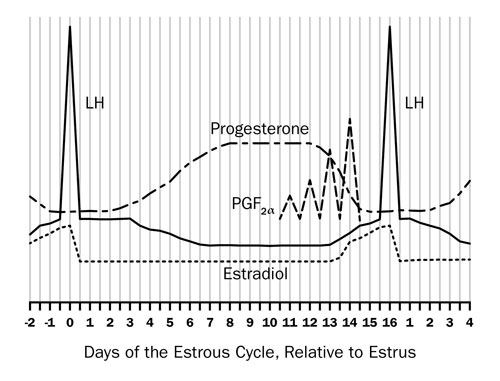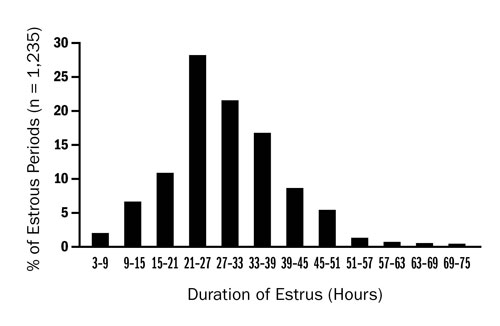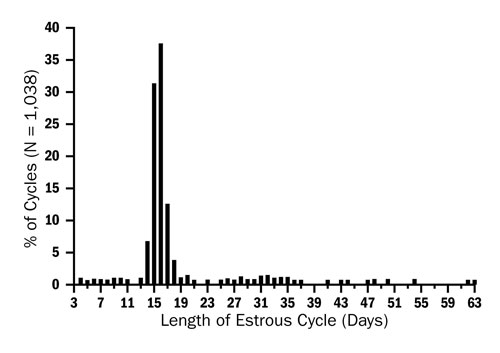Sheep reproduction basics and conception rates
Learn about sheep reproduction. This technical information is for commercial Ontario sheep producers.
ISSN 1198-712X, published July 2012.
Introduction
To run a profitable sheep operation, producers must understand the details of many different disciplines and how they interrelate. One of the basic aspects of a sheep farming operation is to make sure that ewes become pregnant and have lambs. It is important to understand the basic physiology of the reproductive cycle to ensure that management decisions do not prevent ewes from becoming pregnant. Conception rate varies between season, age, breed and lambing system. Understanding the effect of these factors will enable you to determine what a good conception rate is for your farm.
Reproduction basics
Estrous cycle
The estrous cycle is defined as the number of days between the start of two different periods of estrus, or heat. The estrous cycle is controlled by a complex regulatory system involving a number of hormones, as illustrated in Figure 1. The hypothalamus sends gonadotropin-releasing hormone (GnRH) to the pituitary gland, which sends luteinizing hormone (LH) and follicle-stimulating hormone (FSH) to the ovaries, prompting the ovaries to grow follicles.
As the follicles grow, they create estradiol, which is fed back to the brain and causes the ewe to come into heat. The amount of estradiol being sent to the brain increases as the maturing follicles get larger. When the follicles reach 0.5-1 cm in diameter, blood concentration of estradiol peaks, and the brain releases a large amount of LH, which causes ovulation. After ovulation occurs, the follicle that the egg was in collapses and forms a corpus luteum, which secretes progesterone.

This increase in progesterone tells the hypothalamus to decrease production of GnRH, resulting in reduced follicular growth, causing estrus and ovulation to be suppressed as long as the progesterone level is high. If a pregnancy is not established (which would keep the progesterone levels high), the uterus will secrete the hormone prostaglandin F2α(PGF2α<). This hormone causes the corpus luteum to die and decreases progesterone. As a result, the hypothalamus starts producing GnRH, and the cycle begins again.
Duration of estrus
The length of time that most ewes are in estrus, or heat, is generally 24-36 hours.
In a study done in Missouri in 1937, 1,235 cycles were observed in 344 different ewes. Figure 2 shows the distribution of the number of ewes exhibiting heat for each time period. While most ewes exhibit estrus over 24-36 hours, many exhibit heat for either less or more time. Ewe lambs show estrus for a shorter time than mature ewes. Of the cycles studied, 90% were between 15 and 45 hours in length.

Length of cycle
The average length of cycle used for sheep is 17 days. Figure 3 shows the length of 1,038 estrous cycles for 299 different ewes: 90% of the cycles were 14-19 days long, with an average of about 17 days. The start of the estrous cycle is considered to be when ovulation of an egg occurs from the ovary. The end of the cycle occurs just before the next ovulation.
Ovulation
The list below summarizes the basic reproductive characteristics of ewes. Heat and breeding usually begin prior to ovulation, and as a result the sperm are present in the oviduct by the time the egg reaches it. Sperm survive for about 30 hours after breeding. Ovulation usually occurs 24-27 hours after the beginning of estrus. The egg can generally be fertilized for 10-25 hours after ovulation.
Reproductive characteristics of ewes
- Age at puberty (ewe): 6 - 9 months
- Estrus cycle length: 17 days (range 14 - 19)
- Estrus (heat): 24 - 36 hours
- Life span of corpus luteum: 14 days
- Fertilizable life of ova: 10 - 25 hours
Adapted from Hafez
Variation in seasonality
Sheep are seasonal breeders. The natural sexual season is positioned so that lambs will be born in the spring when the weather is warmer and grass is available.
The length of the breeding season varies from one breed to another. Breeds that originated closer to the equator tend to have longer breeding seasons than those that originated further north.

Each year, sheep have a natural breeding season and a period of anestrus. Sheep breed in periods of decreasing day length. The season tends to vary around the shortest day. In the autumn, in days of decreasing daylight, the ewes are in their breeding season. During winter, when days begin to get longer, the ewes are pregnant. They lamb in spring, as the days continue to get longer, and go into anestrus in the summer, with the cycle repeating itself the following year.
David Thomas
Different breeds and length of breeding season
Long season (6 - 8 months)
- Finn
- Romanov
- Dorset
- Rideau
- Rambouillet
- Polypay
Medium season (4 - 6 months)
- Suffolk
- Hampshire
- Oxford
- Canadian
- Charollais
Short season (< 4 months)
- North Country Cheviot
- Leceister
- Scottish Blackface
- Texel
- Shetland
Adapted from Thomas
Inducing estrus
Sheep can be induced to cycle out of season with a treatment of progesterone followed by pregnant mare serum gonadotropin (PMSG). To get good results, a period of progesterone priming is required. The PMSG causes heat and ovulation. Some research projects have also induced sheep to cycle out of season with a treatment of progesterone followed by the sudden introduction of rams (ram effect).
Conception rates
Conception is the point in time when the sperm fertilizes the ova. Conception rate is usually considered to be the number of ewes that lambed compared to the number of ewes exposed to the ram. Using this broad definition of conception rate, more factors can influence the results, because both fertility and embryo loss can be included in the outcome.
In season
Nawaz and Meyer
Ewes were mated for the first time at 18 months of age. Ewes were group mated on pasture to Hampshire rams for 42 days starting the third week in August after exposure to teaser ram for 2 weeks. The ram-to-ewe ratio was 1:50 with rams periodically replaced with fresh rams (Table 1).
There was no significant difference in conception rate between the breeds shown when using the ram effect and exposing ewes in season for several cycles.
Casas et al.
Annual out-of-season
In a follow-up study, Casas et al.
Overall conception rates are much lower in May than in March. There is a significant difference between breeds in the May conception rates. It is interesting to note that the Romanov cross ewes bred as well in May as they did in March.
| Ewe breed composition | Number of ewes bred | Number of ewes lambing | Average conception rate |
|---|---|---|---|
| Coopworth sire | 332 | 320 | 0.95 |
| Polypay sire | 382 | 370 | 0.97 |
| Suffolk sire | 378 | 354 | 0.94 |
| Coopworth dam | 390 | 372 | 0.95 |
| Polypay dam | 702 | 672 | 0.95 |
| Coopworth x Coopworth | 99 | 94 | 0.94 |
| Polypay x Polypay | 236 | 226 | 0.96 |
| Polypay x Coopworth | 146 | 142 | 0.97 |
| Coopworth x Polypay | 233 | 226 | 0.96 |
| Suffolk x Coopworth | 145 | 136 | 0.93 |
| Suffolk x Polypay | 233 | 218 | 0.94 |
| Overall | 1,092 | 1,044 | 0.95 |
| Month of breeding | Conception percentage 1 year-old |
Conception percentage 2 year-old |
Conception percentage 3 year-old |
All ages |
|---|---|---|---|---|
| August | 40.1% | 83.6% | 87.7% | 70.5% |
| October | 66.6% | 93.1% | 94.3% | 84.7% |
| December | 74.7% | 95.3% | 93.9% | 88.0% |
| Overall | 60.5% | 90.7% | 90.2% | N/A |
| Ewe sire breed | Percent conception March | Percent conception May |
|---|---|---|
| Dorset | 82.6% | 62.5% |
| Finn | 91.5% | 72.3% |
| Texel | 89.6% | 52.2% |
| Romanov | 92.4% | 89.2% |
| Montadale | 87.7% | 52.0% |
| All | 88.8% | 65.6% |
Accelerated lambing
Notter
Table 4 also shows significantly lower conception rates out of season compared to in season. The November conception rates are lower than expected rates for ewes bred annually in November. It appears that ewes being bred on an accelerated lambing schedule may have lower conception rates in season.
Lunstra and Christenson
Conception rates were highest among ewes that exhibited estrus within 72 hours of the PMSG injection. In the same study, ovulations were actually counted at 40-70 hours after the onset of estrus. This showed that 98.2% of the ewes tested had ovulated to the synchronized estrus in both the May/June and July/August groups.
The authors speculated that when ewes are treated to breed out of season, there may be greater asynchrony between the time of heat, LH surge and ovulation, particularly in those ewes that don't show heat within 72 hours of PMSG injection. This could be one reason for the difference in the number of ewes in heat and ewes actually lambing.
Target conception rates
Target conception rates are calculated based on either how many ewes produce lambs or how many ewes are pregnant at scanning. Table 6 targets are based on how many ewes produce lambs. Many factors can affect target conception rates. These will differ depending on the age of the ewes, lambing interval, breed and production system. The following suggestions assume 20% ewe lambs in season, no ewe lambs out of season and a minimum of 80 days since the last lambing.
| Month bred | Conception rate |
|---|---|
| August | 90.0% |
| November | 79.0% |
| April | 53.0% |
| Average | 74.0% |
| Group | Number of ewes | Percent ewes showing estrus | Percent ewes lambing |
|---|---|---|---|
| Control May/June | 30 | 10.0% | n/a |
| Control July/Aug | 30 | 16.7% | n/a |
| Treated May/June | 233 | 82.0% | 65.0% |
| Treated July/Aug | 233 | 78.1% | 54.0% |
| Season | Average conception rate | Excellent conception rate |
|---|---|---|
| In | 90% | 96+% |
| Out | 50% to 60% | 70+% |
Factors affecting fertility
Many factors affect conception rates in ewes:
- age
- ram
- health
- nutrition and body condition
- lambing interval
- genetics
- season
- stress and environment
Each of these factors can have a significant effect on conception rate; in some cases, a combination of factors causes conception problems. Out of season, every factor must be managed well in order to have a successful outcome. If conception rates are poorer than expected, review all management factors, including ram management, health, nutrition, lambing interval, age, genetics, stress and environmental factors such as heat.
Conclusions
Good conception rates are essential for the profitability of a sheep farm. High rates of fertility can and should be achieved with an annual lambing system when breeding in season. Breeding out of season most often results in a wide range of conception percentages. Out of season, manage all factors strictly to achieve satisfactory conception results. If conception rates are not high, consider and review the many factors that influence the number of ewes lambing and the number of lambs born, including age, breed, lambing interval, health, nutrition, stress and the ability of the ram.
Footnotes
- footnote[1] Back to paragraph American Sheep Industry Association Production Education and Research Council. 2002. Sheep Production Handbook. C&M Press, Denver Colorado, US.
- footnote[2] Back to paragraph Hafez, B., Hafez, E.S.E. 2000. Reproduction in farm animals. 7th Edition. Lippincott Williams & Willkins, Baltimore, Maryland, US.
- footnote[3] Back to paragraph Thomas, D.L. 2008. Breeds of sheep in the U.S. and their uses in production.
- footnote[4] Back to paragraph Nawaz, M., Meyer, H.H. 1992. Performance of Polypay, Coopworth and crossbred ewes: I. Reproduction and lamb production. J Anim Sci, 70:62-69.
- footnote[5] Back to paragraph Casas, E., Freking, B.A., Leymaster, K.A. 2004. Evaluation of Dorset, Finnsheep, Romanov, Texel and Montadale breeds of sheep: II. Reproduction of F1 ewes in fall mating seasons. J Anim Sci 82:1280-1289.
- footnote[6] Back to paragraph Casas, E., Freking, B.A., Leymaster, K.A. 2005. Evaluation of Dorset, Finnsheep, Romanov, Texel and Montadale breeds of sheep: V. Reproduction of F1 ewes in spring mating seasons. J Anim Sci 83:2743-2751.
- footnote[7] Back to paragraph Notter, D.R., Copenhaver, J.S. 1980. Performance of Finnish Landrace crossbred ewes under accelerated lambing: I. Fertility, prolificacy and ewe productivity. J Anim Sci 51:1033-1042.
- footnote[8] Back to paragraph Lunstra, D.D., Christenson, R.K. 1981. Synchronization of ewes during anestrus : Influence of time of year and interval to onset of estrus on conception rate. J Anim Sci 53:448-457.